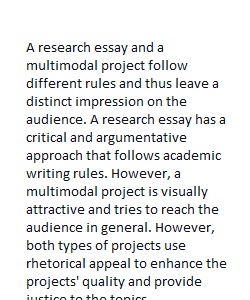


Q Engl 100: Assignment #3b, Rhetorical Analysis and Reflection Overview: • A rhetorical analysis is a careful examination of a text to analyze how its rhetoric (persuasive power) works. For this essay, you will do rhetorical analysis on your final draft of the inquiry essay and on your team multimodal project, comparing the rhetorical approaches used in each, and comparing their effectiveness. Think about how the differences between Essays #2 and #3 changed the rhetoric. How effective is the rhetoric in each assignment—in other words, how persuasive is the rhetoric, and why? Which one has the more effective rhetoric, and why? • At the end of the essay, you’ll reflect briefly on which assignment was a better fit for your personal persuasive abilities, and why. Content requirements: • As part of your rhetorical analysis, include analysis of at least one very detailed example of a specific element in your multimodal project, for example, a specific still or moving image, or a specific use of sound. • By now, you know what kinds of things to analyze when analyzing your rhetoric: things like content and support, clarity, organization, flow, logos/pathos/ethos, but also things like visual rhetoric, your use of the different modes, and of course the matching up of your work’s purpose to your audience. To help you think about your analysis, it may help to look back at the assignment sheets and rubric for Assignment #2 and #3, as well as feedback form that you used to critique the full drafts of the multimodal projects; all of these are at Bb?Course Documents. • As you talk about your work in this essay, refer to your projects by their titles, and refer to yourself in the third person and cite yourself with in-text citations. Example: Shivnan uses so many long, complicated words and phrases, like “heliocentric” (3) and “oleaginous odors in the offing” (2), that the essay’s persuasiveness is reduced. • Include a clear thesis—the overall claim you want to make about your rhetoric in Assignment #2 and #3. It may help to write the body of your essay first, before you decide on your thesis because writing the draft can help you discover your thesis. Format requirements: • Your final draft must be 600-900 words; this is not very long—make every word count! • Your final draft must be double-spaced MS Word documents, with a title and a heading with name and word count. • Include a Works Cited page (not included in the word count) with two sources: your own Essay #2 and your team’s Assignment #3a project. o For your Works Cited, follow this format for Assignment #2: Last name, first name. “Title of essay.” Inquiry essay. ENGL 100, UMBC. Baltimore, MD. Date of submission. o And follow the format for Assignment #3 that is given on p.156 in Little Seagull for “online video” or if your team project is an MP4 and therefore is not online, just omit the host site from the listing. For the author’s name, use the team leader’s name followed by “et al.” • Upload Assignment 3b to Assign.
View Related Questions